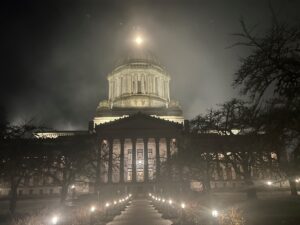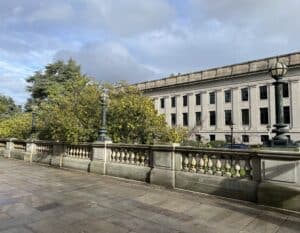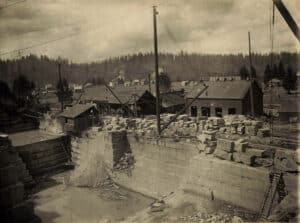
Notes From Olympia: Jan. 26, Week 3 of the 2024 Legislative Session
This edition includes highlights from legislative week 3, updates on key early learning related bills, Washington state trivia and much more.
 A foggy and misty start to week three
A foggy and misty start to week three
(Photo Credit: Erica Hallock)
Trivia!
State Symbols. Representative Peter Abbarno’s HB 1977 would designate what type of stone as Washington’s official state rock?
Week 3 Highlights
And Then There Were Five
This week, Secretary of State Steve Hobbs notified the Legislature that signature verification and certification had been completed for two additional Initiatives to the Legislature, bringing the total number of certified Initiatives to the Legislature to five. Last week’s Notes From Olympia shares a deeper dive on Initiatives to the Legislature.
The two added Initiatives to the Legislature relate to repealing the state’s capital gains tax and prohibiting the state, counties, cities or other local governments from instituting an income tax.
The remaining potential Initiative to the Legislature still in the process of signature verification (as of this writing) relates to the repeal of the state’s long-term care insurance program.
On to Bills
With the first cutoff date rapidly approaching Jan. 31, dreams are being made – or broken – by the policy committee hearing schedules. We are at the point of session where bills are constantly being added to (and removed from) committee schedules. Schedules are very fluid, and it is not uncommon for policy committee agendas to simply read “bills referred to committee” with the actual agenda items filled in throughout the week. This can make it challenging for planners like me as well as for those who are anxious to see if their bills are going to receive a hearing. It is also important to know that not every bill receives a public hearing and not every bill that receives a public hearing will advance to executive session – or a vote.
The legislative process is designed to narrow down the number of issues under consideration via these cutoff deadlines. There is not enough time – or funding – to allow for all the great ideas to make it through the process each year. While this is frustrating, this reality also provides opportunities to fine tune ideas and build support and awareness when groups return in future years. (I’m trying to put a positive spin on the disappointment we all feel when our passion projects do not advance).
Tax Policy and Child Care. This week, fiscal committees heard three bills related to child care and tax policy:
- On Jan. 23, the House Finance Committee heard HB 1716 by Representative Rule which would establish a Business & Occupations (B&O) Tax Credit for businesses that provide child care assistance to employees.
- The House Finance Committee also heard HB 2322 by Representative Senn which would require employers that receive a (B&O) tax preferences from the state provide child care for their employees.
- Finally, the Senate Ways and Means Committee is slated to hear SB 6038 by Senator C. Wilson Jan. 25. SB 6038 would both eliminate child care licensing fees and provide a tax exemption for businesses that receive income from child care.
At the hearings, proponents spoke to the importance of affordable, accessible child care, emphasizing the state’s child care crisis is a significant workforce issue. According to the Washington State Child Care Collaborative Task Force, in 2020, 71% of parents cited difficulty in finding child care that impacted their ability to work. These proposals reflect differing approaches to tackling this crisis from the tax policy standpoint. As of this writing, none of the bills have been scheduled for an Executive Session.
Late Week Two Activity
Early Learning Facilities
On Jan. 18, the House Capital Budget Committee heard HB 2195 by Representative Callan which would make changes to the Ruth LeCocq Kagi Early Learning Facilities Fund (ELF). The bill would take a number of actions, including changing the distribution of any capital gains tax revenue received above $500 million so that 25% of the overage would be directed to the Early Learning Facilities Fund and 75% to the Common School Construction Fund; removing ELF award limits; adding translation services as an eligible administrative cost; prioritizing applications that are ready for construction, renovation, purchase, or repair; and eliminating the match requirement for ELF facilities collocated with housing developments, allowing them to receive state funding for 90% of the project cost.
The bill received widespread support at the hearing from the child care community, with testimony leading off from former Representative Ruth Kagi who spoke about the genesis of the ELF and the critical need for early learning facilities. Two early learning providers who had previously received ELF funding spoke to the importance of the fund, particularly in a field with narrow profit margins. One provider noted her construction costs had jumped substantially from the start of her project to now, highlighting the need to adjust the caps on grant award levels.
Those who testified “other” or “con” expressed concerns about the sustainability of the funding source and those affiliated with the K-12 system were concerned about diverting capital funding from the Common School Construction Fund.
As of this writing, HB 2195 has not been scheduled for Executive Session.
What’s on Deck for Next Week?
As noted above, policy committee cutoff is scheduled for Jan. 31. The Legislature will then swiftly shift into fiscal committee work – with weekend hearings scheduled – to meet the quick turnaround of a Feb 5 fiscal committee cutoff. This fast turnaround requires us all to be on our “A” games, making sure bills with a fiscal impact not only get scheduled for a public hearing in a fiscal committee, but are also scheduled for executive session (or vote).
Fiscal committees are another place where great ideas get squashed or receive a “haircut.” It is not unusual to see amendments added to bills scaling back proposals, and nearly every bill passed out of a fiscal committee will include a caveat “subject to the appropriation of funding…” This condition means implementation of the policy is dependent upon the item being included in the adopted budget. This gives lawmakers the ability to keep a bill moving while making its implementation dependent upon funding.
SSB 5774 by Senators Billig and C. Wilson is slated to be heard in the Senate Ways and Means Committee Jan. 29. SSB 5774 aims to utilize DCYF local offices for fingerprint background checks as a way to ease the backlog and ease access, particularly in rural areas. It was amended in the Senate Early Learning and K-12 Committee to lower its fiscal impact by limiting the number of DCYF staff and offices impacted.
Child Care Licensing, Educational Requirements and Siting
On Jan. 30, the House Human Services, Youth and Early Learning Committee will hear two bills related to child care licensing and educational requirements.
- The first bill, HB 2046, with Rep. Dent as the prime sponsor, would make changes to educational requirements and licensing for providers in child care deserts in rural communities (as defined by DCYF).
- Specifically, DCYF would be required to contract with a nonprofit focused on child care to develop a handbook for child care providers that focuses on the health, safety and nutritional needs of children; how to establish a nurturing relationship with children; and the fundamentals of instruction. Child care providers in these rural counties identified as child care deserts would be exempt from educational requirements and instead would be required to read this handbook and attest it was read.
- The bill would further make changes to class sizes and ratios in these rural counties designated as child care deserts, changing the class size for preschoolers to 21 and the provider to student ratio to 1:11. For school-age, the class size would change to 31 and the provider to student ratio to 1:16. Finally, the requirement for licensed indoor program space would change to 34 square feet per child in attendance.
- The second bill being heard in this House committee Jan. 30 is HB 2179 by Rep. Couture. This measure would allow counties with a population of less than 100,000 to license and regulate child care centers and family child care homes from July 1, 2025 through June 30, 2032. The bill outlines the components the local licensing and regulation must cover. Further, the bill would require a third-party assessment of any local licensing and regulation.
Neither bill has an Executive Session scheduled as of this writing.
Over in House Local Government
- HB 2468 by Representative Jacobsen is scheduled for a Public Hearing Jan. 30 and Executive Session Jan. 31. This bill aims to streamline local permitting and zoning requirements in order to allow for siting of child care centers near elementary schools.
Bill Tracker
Our bill tracker is updated each Thursday and linked on our policy resources page. Because bills move quickly, the tracker may not have the most recent updates, but this information can be found on the legislative website.
Trivia Answer
HB 1977, sponsored by Representative Peter Abbarno, would make Tenino sandstone the official state stone. This bill rocks! (Come on, that’s some low hanging fruit!).
 Many of the buildings around the Capitol (including the Insurance Building pictured above) are built using Tenino sandstone, our potential future state rock!
Many of the buildings around the Capitol (including the Insurance Building pictured above) are built using Tenino sandstone, our potential future state rock!
(Photo Credit: Zoë Erb)
I will admit that when I saw the title of this bill, it did give me pause. I am familiar with state flowers, state flags, even state songs. But, apparently, 29 states have a designated state rock and, if HB 1977 is enacted, Washington would become state #30. As Zoë and I looked into the background on this bill, we learned there’s more to the story – as there often is – with historic, economic and geographic significance.
Tenino sandstone hails from the city of Tenino in Southern Thurston County, part of Representative Abbarno’s district. Incorporated in 1906, the City of Tenino has a current population of just under 2,000 residents today.
Sandstone is prevalent in many areas of southwestern Washington. In our research, we learned sandstone is easy to cut but, after being exposed to air, it becomes hard, making it ideal to use as a building material. Due to its availability and suitability for constructing buildings, sandstone became a key part of the Tenino economy with the establishment of sandstone quarries. (Honestly, I now want to try to cut some Tenino sandstone. Is it like butter? I must find out).
In the late 1880s/early 1900s, Tenino sandstone was commonly used in building construction, but its popularity increased after the San Francisco earthquake of 1906 and fires in Seattle and other major cities. This is because as earthquakes and fires ravaged cities, buildings constructed with Tenino sandstone persevered. That’s PR you just cannot buy!
Bringing it back to a tie to Olympia, Tenino sandstone was used in the construction of the Washington state Legislative Building, and when the building was damaged after the 2001 Nisqually earthquake, members of the Tenino Stone Carvers Guild assisted in the Capitol repair. Zoë and I chatted with a kind Capitol docent Richard who shared with us that you can view the sandstone on the external portions of the Legislative and other campus buildings. While the inside of the Legislative building is clearly marble, the outside has a sandstone look to it.
Notably, Tenino sandstone is present in the “other Washington” as it was used to carve the stone that represents Washington state at the Washington Monument.
In a press release, the bill sponsor Representative Peter Abbarno expressed the rationale behind his bill as: “There are so many buildings and monuments in the state of Washington that were built and designed with Tenino sandstone. You can’t visit the Capitol without seeing Tenino sandstone or the craftsmanship of the Tenino Stone Carvers Guild. It is fitting to designate Tenino sandstone as our ‘state stone.’”
HB 1977 was referred to the House State Government and Tribal Relations Committee. It has not had any movement, so it is unlikely to advance in 2024, but the readers of this newsletter are more knowledgeable about Tenino sandstone! Thank you, Representative Abbarno.
Three more fun facts about the City of Tenino:
- One of the largest explosive detonations in state history occurred here. In 1912, two trains filled with black powder and dynamite were used to create the “big blast,” producing approximately 500,000 tons of rockfall. The sandstone boulders were apparently needed for a jetty in Grays Harbor.
- Tenino’s other claim to fame is its creation of its own local currency (in the form of wooden money), to help locals get through the Great Depression. (Now there’s a future trivia item).
- Today, you can swim in the old quarry in the city park, the site of the old Tenino Stone Company. ROAD TRIP!
 Former Tenino Stone Company Quarry
Former Tenino Stone Company Quarry
Current Site of Tenino Quarry Pool
(Photo Credit: City of Tenino)
Resources: The Department Of Natural Resources: “Tenino”; Representative Abbarno’s Newsletter: “Tenino sandstone built Washington, and should be the state rock says Rep. Peter Abbarno”
About the Author

Erica Hallock
Director, Policy & Advocacy, Start Early Washington
Erica Hallock serves as the Director of Policy and Advocacy for Start Early Washington. She has worked in early childhood, health and human services policy in both California and Washington state.
More Like This
Contact Us
Connect with our team to learn more about our work or discuss how we can support policy and advocacy work for your organization.
Washington State Hub
Learn more about our work in Washington state and access relevant resources and publications.
